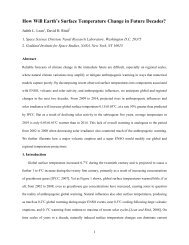Effects <strong>of</strong> the Weak Polar Fields <strong>of</strong> Solar Cycle 23 357second panel marks the projected Ulysses trajectory for this Carrington rotation (data isfrom http://cohoweb.gsfc.nasa.gov/helios/heli.html).The third panel <strong>of</strong> Figure 14, similar to Figures 12 <strong>and</strong> 13, shows the WSA model predictions<strong>of</strong> the coronal hole areas <strong>and</strong> the solar wind speeds arising from them. The crossesmark the daily position <strong>of</strong> the sub-Earth point on the Sun, providing information about wherethe solar wind observed at Earth is coming from on the Sun. For CR 1898, the majority <strong>of</strong>the medium- to high-speed winds in the ecliptic are coming from the PCH edges <strong>and</strong> extensions.Noteworthy are subtle differences between the top <strong>and</strong> third panels with regardto the open field areas, in terms <strong>of</strong> shapes, locations, etc. These differences arise becausethe PFSS model here uses magnetograms from WSO whereas the WSA model uses magnetogramsfrom the National Solar Observatory (NSO) (Henney, Keller, <strong>and</strong> Harvey, 2006)<strong>and</strong>a coupled coronal model consisting <strong>of</strong> the PFSS <strong>and</strong> Schatten current sheet model (Schatten,1971). However, these differences do not affect the basic information obtained from thesesource mappings.The bottom panel <strong>of</strong> Figure 14 shows the mapping <strong>of</strong> the magnetic field magnitudeat 1 AU based on the open field regions shown for CR 1898. The results are generatedby the coupled coronal MHD Around a Sphere (MAS) model (Riley, Linker,<strong>and</strong> Mikic, 2001), together with the ENLIL solar wind model (Odstrcil, 2003) (henceforthMAS/ENLIL). The coupled model uses NSO magnetograms <strong>and</strong> is publicly availablethrough the runs-on-request service at the Community Coordinated Modeling Center(CCMC) (http://ccmc.gsfc.nasa.gov). The colors shown are the field magnitude values in theunits <strong>of</strong> nanotesla, though it should be mentioned that the MAS/ENLIL solar wind modelvalues tend to be underestimated by a factor <strong>of</strong> ≈2 compared to observations (see Lee etal., 2009, for a discussion). The regions <strong>of</strong> low field magnitudes (patches <strong>of</strong> dark blue) areconfined to a narrow latitudinal range <strong>and</strong> usually coincide with the rarefaction regions inthe trailing parts <strong>of</strong> the high-speed streams (e.g., Figures 7 <strong>and</strong> 8), which in this case areconfined to fairly low latitudes.Figure 15 shows similar plots to Figure 14 but for CR 2060 during the SC 23 period.The top panel shows six isolated low- to mid-latitude coronal holes that map out to a muchwider range <strong>of</strong> latitudes at the source surface (second panel) than for the SC 22 periodshown previously. In addition, the open field regions from the PCH regions do not have aslarge a latitudinal extent over a broad range <strong>of</strong> longitudes, in contrast to Figure 14 (secondpanel), which is representative <strong>of</strong> the SC 22 period. Other Carrington rotations from theSC 23 period also show the low- to mid-latitude coronal holes mapping out to a much widerlatitude range over a broad range <strong>of</strong> longitudes at the source surface. This is consistentwith the Ulysses results <strong>of</strong> McComas et al. (2008), who also showed that the b<strong>and</strong> <strong>of</strong> solarwind variability has a larger latitudinal extent for this period compared with the previousSC 22 period. The implication is that Ulysses would have spent more time during the SC 23period in the solar wind emanating from the low- to mid-latitude sources than in the previousperiod. The solid blue curve shown in the second panel marks the Ulysses trajectory for thisCarrington period, showing that Ulysses was crossing the ecliptic plane during this time.The third panel shows the WSA predictions <strong>of</strong> the coronal holes <strong>and</strong> the speeds arising fromthem. In the ecliptic plane, most <strong>of</strong> the high-speed winds were coming from these low- tomid-latitude sources <strong>of</strong> open fields, in contrast to the previous period where the majority <strong>of</strong>the high-speed winds came from the PCH edges. The bottom panel shows the MAS/ENLILmodel results for the field magnitude at 1 AU. Regions with low field magnitude values aremore abundant during this period <strong>and</strong> have a broader latitudinal range compared with theprevious period.The evolution <strong>of</strong> stream interactions <strong>and</strong> their related rarefactions may contribute to theweaker fields that are observed during this current minimum period. We investigate how the
358 C.O. Lee et al.Figure 15 Global outward mapping <strong>of</strong> coronal holes supplying the solar wind for CR 2060 during the SC 23period. (Top panel) The open (color dotted areas) <strong>and</strong> closed (areas with blue – red field lines) field regionsbelow 1.25R ⊙ . (Second panel) The photospheric sources mapped out to the source surface at 2.5R ⊙ .Thetwo solid gray bars mark the ecliptic plane location (between ±7.25° latitudes). The thick blue curve marksthe projected Ulysses trajectory. (Third panel) The WSA model predictions <strong>of</strong> the coronal hole areas <strong>and</strong> thesolar wind speeds arising from them. (Bottom panel) The magnetic field magnitude at 1 AU modeled by thecoupled MAS/ENLIL solar wind model. The black curve seen throughout is the magnetic neutral line.depth <strong>of</strong> the rarefactions, <strong>and</strong> thus the associated field magnitudes, depend on the low- <strong>and</strong>high-speed contrasts <strong>of</strong> the solar wind streams. Figures 16 <strong>and</strong> 17 illustrate the basic dynamicalfeatures <strong>of</strong> corotating compression <strong>and</strong> rarefaction regions in the equatorial plane (e.g.,Pizzo, 1982; Riley, Linker, <strong>and</strong> Mikic, 2001). These numerical results are from the MAScoronal–solar wind model <strong>and</strong> were used by Riley <strong>and</strong> Gosling (2007) to study the origins<strong>of</strong> radial heliospheric fields in high-speed stream rarefaction regions. The initial conditionsfor the simulations consisted <strong>of</strong> a 300 km s −1 slow-speed stream throughout, with a singlehigh-speed stream <strong>of</strong> either 400 km s −1 (Figure 16a) or 800 km s −1 (Figure 16b) from a




![When the Heliospheric Current Sheet [Figure 1] - Leif and Vera ...](https://img.yumpu.com/51383897/1/190x245/when-the-heliospheric-current-sheet-figure-1-leif-and-vera-.jpg?quality=85)

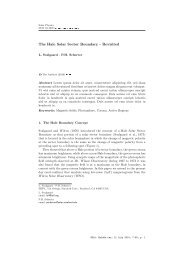

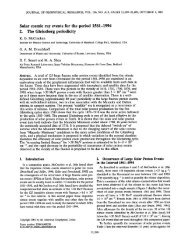
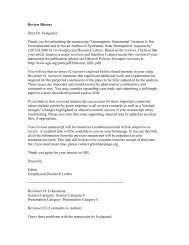

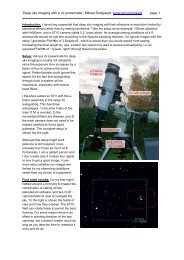
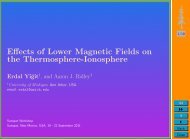
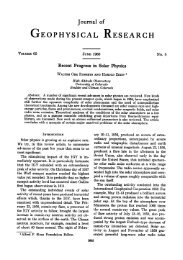
![The sum of two COSine waves is equal to [twice] the product of two ...](https://img.yumpu.com/32653111/1/190x245/the-sum-of-two-cosine-waves-is-equal-to-twice-the-product-of-two-.jpg?quality=85)
